| |
|
St
Andrew, Wickmere
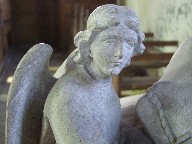 |
|
It
was an unseasonably warm day in early October
2011, the thermometers just touching eighty
degrees in the balmy rolling landscape of north
Norfolk. As I cycled along the lane from
Aldborough, I cast my mind back to the first time
I had come this way, more than six years before.
That was in high summer, but I remembered the
wind the first time, its blustery getting up, its
flurrying the high grasses. Now in October the
air above me was deep blue and hazy, but back
then the clouds had frowned and scuttered in the
wide Norfolk sky. Me then, me now. It had
been early August 2005 I remembered, a day in
that mixed summer of heat and rain and
unpredictability. My friend Tom Muckley and I had
come here to Wickmere in the late afternoon at
the end of two days exploring churches in the
area between Cromer and Aylsham; Wickmere was
church number 32. One of the great joys of
visiting churches in this area is that nearly all
of them are open and welcoming to visitors; but
St Andrew wasn't then, and it wasn't on a couple
of subsequent occasions. It was a shame. There
was no keyholder listed, so we peered through the
little barred window in the door, but we couldn't
see much inside at all.
|
Instead, we wandered in the graveyard,
remote at a crossroads with few other buildings in sight.
Below its feminine late medieval crown, the narrow round
tower begins in a rather austere manner, a little like a
chimney of a Cornish tin mine, before tapering towards
pretty 14th century bell windows. Now, in 2011, that same
tower beckoned across the fields, many already ploughed
and drilled as the Norfolk farmers stole a march before
the land put itself to sleep for another winter. The
hedgerow was full of high grasses, and St Andrew came
into view across a field still wearing its barley stubble
like an old cloak, still to be drawn back under the
ground. I thought of Tom, dead now, his ashes scattered
across a Norfolk field like this one.
This was my last bike ride in Norfolk of
2011. I was cycling from Cromer to Norwich, to catch the
train there back to Ipswich. Not a huge distance, but the
pleasant meandering around lanes and the cutting off at
tangents to visit churches, most of them old friends,
would make it about forty miles all told. It is hard for
me now, a couple of months on, to remember quite how warm
it was that day, and how humid the air was in the sunken
lanes around the Barninghams and the wide park of
Wolterton Hall, home of the Walpoles. It was an utter joy
to be flying through the landscape on my new bike, a few
months old, a drop handle tourer which was still a
novelty after years of hybrids. I had not owned a steel
touring bike since I was in my twenties, and in truth a
feeling of those days came back to me as the wheels spun
on their bearings down the narrow Norfolk lanes. And
there was an added excitement because I knew that
Wickmere church would be open; I had finally got into
Aylmerton church earler that day, and so St Andrew,
Wickmere, was the very last north Norfolk church which I
had not previously seen inside.
St Andrew is a rare 20th century example of
what was commonplace at the time the tower was topped; a
major restoration paid for from a bequest, with the
provider of that bequest memorialised in effigy inside.
He was Baron Walpole, the fifth Earl of Orford, who died
in 1935. The Orfords traced their title back to Sir
Robert Walpole, Prime Minister, and the ruination of the
church beside their Hall at Wolterton led them to adopt
this one. Walter Caroe was paid to thoroughly rescue this
building from collapse, which was accomplished before the
Second World War broke out. Tie beams stopped the
clerestory and roof pushing the arcades outwards, and the
bulging of the tower was drawn back by tie beams about
halfway up. The fifth Earl now lies, patiently asleep,
inside; he rests in his robes, angels at his head and a
goat at his feet in the medieval manner, and yet looking
the very model of the early 20th Century aristocracy
which was devastated by the First World War. I thought of
Betjeman: Old men in
country houses hear clocks ticking over thick carpets
with a deadened force; Old men who never cheated, never
doubted, Communicated monthly...
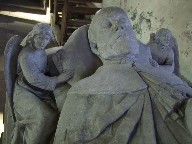
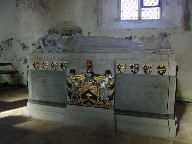
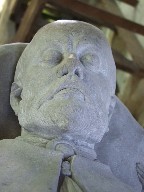
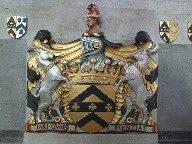
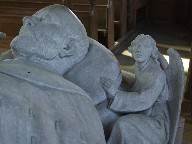 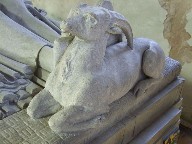 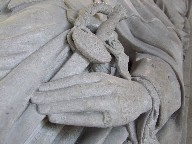 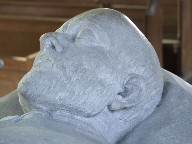
St Andrew is a church
of uncommon interest, and is thanks to the sleeping Earl
that it has been preserved for us. An extraordinary war
memorial waits just inside the south door, an angel
holding a roll. A medival minstrel strums a lute on a
bench end, grinning wildly and looking for all the world
like a 15th Century George Formby. Two ghosts from a late
medieval memorial kneel headless in a window splay. Not
only does the screen have Saints in the dado, but two
of the panels from the Wolterton screen, depicting
donors, are now fixed to the 1930s pulpit. A late 17th
Century ledger stone indulges in a rather extraordinary
theological debate: But is Gunton dead, what doest
thou say? His soul is a live, his body here doth lay but
in a sleep until ye Judgement Day, and live he shal until
Eternity. Men say he's dead, I say so too, and ere a
while they'll say ye same of you.
But all around are the
Walpoles who came here to rest. A smaller angel
in a chancel window splay remembers Horatio
Corbin Walpole, born at 15 Grosvenor Square
London 9th January 1891, died at Waborne Hall
Norfolk 20th May 1893. Poor little Horatio
presumably lies in the churchyard, because this
is actually a fairly conventional outdoor
gravemarker, perhaps brought into the church at
the time of the 1930s restoration.
As well as the war memorial, St
Andrew contains a WWI battlefield grave marker
for Horatio Spencer Walpole, a cousin of the
Walpoles of Wolterton. He was killed on the Arras
front in April 1918, and is buried at Bac de Sud
Cemetery near Bailleulval, not far from where he
fell. His cross came home to be with the long
Walpole generations.
|
|
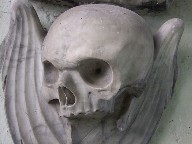 |
Simon Knott, January 2012
|
|
|
